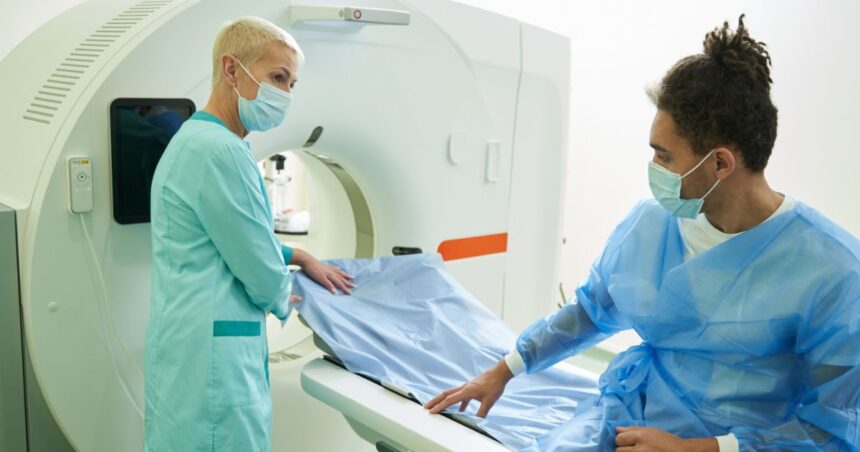PET-CT scans are a powerful tool used by doctors to detect cancer early. By combining two imaging technologies, PET-CT scans can provide a clear and detailed look inside the body.
This makes it easier for doctors to find cancer and understand how it affects a patient. I will discuss the importance of PET-CT scans in early cancer detection.
What is a PET-CT Scan?
A PET-CT scan is a type of medical imaging that combines two different types of scans: Positron Emission Tomography (PET) and Computed Tomography (CT). The PET scan helps show how tissues and organs work, while the CT scan provides detailed pictures of the body’s internal structures.
These two technologies create a more complete image, allowing doctors to see tissues’ physical details and functional activity. This combination is beneficial when looking for cancer because it shows where a tumor might be and whether it is active or spreading.
How PET-CT Scans Help in Early Cancer Detection
Early cancer detection is crucial for successful treatment. PET-CT scans are very effective in finding cancer at an early stage. They help doctors see if there are any unusual changes in the body before a patient starts to feel sick.
PET scans can identify changes in cellular activity, which often happens before a tumor grows large enough to be seen on a regular scan. By detecting cancer early, doctors can start treatment sooner, increasing the chances of recovery and successful patient outcomes.
Benefits of PET-CT Scans Over Other Imaging Tests
Compared to other imaging tests, PET-CT scans have several advantages. One of the most significant benefits is that they provide more information than a CT or MRI scan alone. While CT and MRI scans show detailed images of the body’s structure, they cannot tell if a mass is growing or spreading.
On the other hand, PET-CT scans can show how active a cancerous area is by detecting chemical changes in the body. PET-CT scans are beneficial for diagnosing, staging, and monitoring cancer treatment. The ability to see anatomy and activity gives doctors a clearer picture, allowing for better decision-making.
Staging and Monitoring Cancer with PET-CT
Staging cancer means figuring out how far it has spread in the body, which is a critical part of planning treatment. PET-CT scans are very effective because they highlight cancerous cells and show how far they have moved. Once treatment starts, PET-CT scans are also used to monitor progress.
Doctors can compare current scans with previous ones to see if the cancer is shrinking, staying the same, or growing. This helps them decide if the current treatment is working or changes need to be made. PET-CT scans give doctors and patients valuable information to make informed choices during cancer care.
Why Early Detection Saves Lives
Finding cancer early can make a massive difference in treatment success. When cancer is caught early, treatment options are usually less aggressive, and the chances of a full recovery are much higher. PET-CT scans help doctors catch cancer before it causes severe symptoms, giving patients a better chance at a positive outcome.
For many types of cancer, early detection can mean the difference between needing minor treatments or more intense therapy. By using PET-CT scans as part of regular checkups for people at risk, doctors can identify and address cancer earlier than ever before.
Who Should Get a PET-CT Scan?
Not everyone needs a PET-CT scan, but certain groups can benefit the most. Patients who have a higher risk of cancer due to family history or genetic factors may be recommended for a PET-CT scan by their doctors.
Patients who already have a diagnosis of cancer may need a PET-CT scan to help determine how far it has spread or to track how well their treatment is working. People who have had cancer in the past may also need these scans to check for recurrence. The decision to get a PET-CT scan is usually made by a healthcare provider who understands the patient’s history and risk factors.
Safety and Accuracy of PET-CT Scans
PET-CT scans are both safe and highly accurate. The PET part of the scan uses a small amount of radioactive material to highlight areas of activity in the body. The radiation level is low and considered safe, especially when weighed against the benefits of early cancer detection. The CT part of the scan uses X-rays to take detailed pictures, which helps doctors see any unusual growth.
Together, these two types of scans are reliable in finding cancer, making them a critical tool in modern cancer care. The accuracy of PET-CT scans also helps reduce the need for other, more invasive tests, which can be uncomfortable and time-consuming.
Conclusion
PET-CT scans are an important part of early cancer detection and treatment. By combining two powerful imaging techniques, these scans provide doctors with a detailed view of what is happening inside the body. This helps with early diagnosis, staging, and monitoring of cancer, leading to better patient outcomes.
Early detection can save lives, and PET-CT scans are one of the most effective tools for catching cancer before it becomes more serious. Being proactive and using advanced technology like PET-CT scans can significantly affect the fight against cancer.

